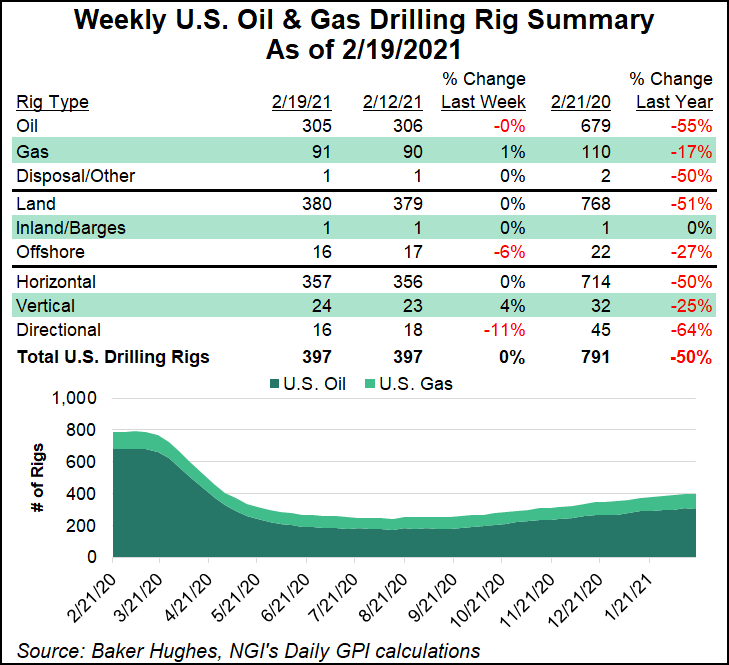The United States added one natural gas rig to grow its tally to 91 for the week ending Friday (Feb. 19), while the departure of one oil-directed unit left the overall domestic tally unchanged, according to the latest data from Baker Hughes Co. (BKR).

The combined U.S. rig count ended the period at 397, which is 394 units shy of the 791 rigs active in the year-ago period, according to the BKR numbers, which are based partly on data from Enverus.
Land drilling increased by one unit, while the Gulf of Mexico dropped one rig to fall to 16, versus 22 a year ago. Directional units decreased by two, while one horizontal rig and one vertical rig were added during the week.
The Canadian rig count contracted four units to 172, including a decline of three gas-directed units along with one oil-directed. That left the Canadian count 72 units shy of the 244 active rigs in the year-ago period.
The combined North American rig count fell to 569 for the week, versus 1,035 at this time last year.
Broken down by play, the Permian Basin added one rig for the week, upping its total to 204. That’s still less than half of the 409 rigs active there at this time last year, BKR data show. The Williston Basin also added a rig for the week to finish with 14, versus 53 a year ago.
Broken down by state, North Dakota and Texas each added one rig, while Alaska and Louisiana each dropped one rig from their respective totals.

The U.S. Energy Information Administration (EIA) said in its most recent Weekly Petroleum Status Report that domestic crude oil inventories dropped substantially for a second straight week for the week ended Feb. 12 as demand increased and production declined.
Analysts said the surge in frigid weather that blasted the nation’s midsection this past week and upended daily life in Texas is bound to lead to EIA reporting another withdrawal in the week ahead.
Icy roads were limiting travel and curbing demand for gasoline in Texas and neighboring states, and refinery outages were hindering crude demand. Still, production was estimated to be down 40% at midweek because of power outages and frozen well operations, likely enough to require another pull to meet national demand.
Meanwhile, reports surfaced earlier in the week that Saudi Arabia, which leads the Organization of the Petroleum Exporting Countries (OPEC), may quickly ramp up production this spring, following the recent momentum in oil prices and its own expectations for increased demand in the second half of 2021.
Saudi Arabia could announce the shift in policy when OPEC and its allies meet early next month, the Wall Street Journal reported Wednesday, citing advisers to the cartel.

